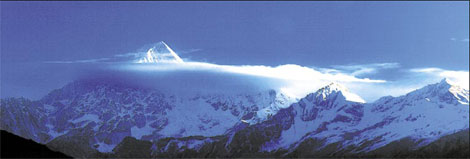Special supplement: Journey to Sichuan's spectacular 'Four Sisters' Mountains
|
Snow-covered Siguniang Mountains |
The mention of the Longmenshan National Geological Park in Sichuan province normally conjures up images of beautiful snow-capped mountains and clear streams.
But Longmenshan became a famous name for another reason on May 12, when an earthquake wreaked havoc along the Longmenshan Fault in Sichuan province where the park is located. Yet it is exactly geologic action that has made the park the wonder that it is.
The park starts from Cifeng town in Pengzhou, a city under the administration of Chengdu, and ends in Taiping town in Mianzhu, a city in northern Sichuan. The 55 km-long park covers more than 1,900 sq km.
With many Paleozoic rocks from different ages, the park shows the evolution of geology and is hailed as a geological maze.
Isotope analysis shows that diorite in park is more than 2 billion years old. Its granite dates back more than 1 billion years and its complex strata formed between 654 million and 767 million years ago.
In addition to its geological marvels, the park's beautiful mountain scenery is home to rare plants and animals, including the giant panda.
Siguniang Mountains
Like the park, the Siguniang - Four Sisters - Mountains are known for their beauty.
In the opinion of many, the country's most beautiful mountain range is not on the usual list discussed in tourist books. Their No 1 choice for scenic beauty is the Siguniang Mountains in the Aba Tibetan and Qiang autonomous prefecture of Sichuan.
The mountain range's four snow-covered sister peaks are home to a treasure trove of animals including the giant panda and snow leopard, as well as hundred of plants.
Like many scenic spots in the country, the mountains have an intriguing legend. In an unknown dynasty, the legend says, a mountain god named Balang had four beautiful daughters. A devil admired the girls' beauty and wanted to marry them. He suggested to the mountain god that they fight a duel. If he won, he would get the girls.
The mountain god was killed in the duel and the girls fled. They made it as far as Xiaojin county in Sichuan before freezing to death in the valley. Over time, the sisters' remains rose to form the four peaks, protecting local people from floods and beasts.
Their bodies became the Siguniang Mountains and their father became the Balang Mountains.
The Siguniang Mountains are sacred to the indigenous population. Every May 4 on the Chinese lunar calendar local Tibetans dressed in their best and riding horses decorated in red proceed to the peaks for a memorial ceremony. The tradition is hundred of years old and is the largest activity of the year.
Another tale holds that the four girls were later saved by a hunter and became fairies.
Many observers think the Siguniang Mountains do resemble four graceful fairies wearing mantles of white and waving from afar.
Today's visitors are greeted at the entrance to the scenic area by four young and beautiful Tibetan girls in traditional garment.
They present every guest with a white hada - a long piece of silk used as a greeting gift among Tibetans - and a bowl of barley beer.
Special experience
Tibetans are known for their hospitality. During the dinner, girls sing and dance, toast and offer their best wishes to guests. On the dinner menu are yak meat, mushrooms and barley beer.
Yaks are ubiquitous in Aba and their meat is favored by many visitors.
It is nothing extraordinary if a Tibetan family in the prefecture owns more than 100 yaks, each of which are highly valuable.
Yaks wander through flower blossoms above the clouds while a thick forest stands below. Due to atmospheric conditions, the clouds are able to continuously wave even in windless conditions on the ground, creating a spectacular site.
The 6,250-m-high Siguniang Mountains contain the Shuangqiao, Changping and Haizi valleys. Some have termed the range the "Oriental Alps."
(China Daily 08/24/2008 page15)















